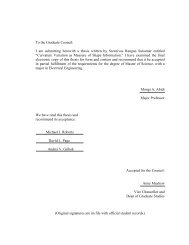To the Graduate Council: I am submitting herewith a dissertation ...
To the Graduate Council: I am submitting herewith a dissertation ...
To the Graduate Council: I am submitting herewith a dissertation ...
- No tags were found...
You also want an ePaper? Increase the reach of your titles
YUMPU automatically turns print PDFs into web optimized ePapers that Google loves.
AbstractThe focus of this research is on building 3D representations of real world scenes andobjects using different imaging sensors. Primarily range acquisition devices (such as laserscanners and stereo systems) that allow <strong>the</strong> recovery of 3D geometry, and multi-spectralimage sequences including visual and <strong>the</strong>rmal IR images that provide additional scenecharacteristics. The crucial technical challenge that we addressed is <strong>the</strong> automatic pointsetsregistration task. In this context our main contribution is <strong>the</strong> development of anoptimization-based method at <strong>the</strong> core of which lies a unified criterion that solvessimultaneously for <strong>the</strong> dense point correspondence and transformation recovery problems.The new criterion has a straightforward expression in terms of <strong>the</strong> datasets and <strong>the</strong>alignment par<strong>am</strong>eters and was used primarily for 3D rigid registration of point-sets.However it proved also useful for feature-based multimodal image alignment. Wederived our method from simple Boolean matching principles by approximation andrelaxation. One of <strong>the</strong> main advantages of <strong>the</strong> proposed approach, as compared to <strong>the</strong>widely used class of Iterative Closest Point (ICP) algorithms, is convexity in <strong>the</strong>neighborhood of <strong>the</strong> registration par<strong>am</strong>eters and continuous differentiability, allowing for<strong>the</strong> use of standard gradient-based optimization techniques. Physically <strong>the</strong> criterion isinterpreted in terms of a Gaussian Force Field exerted by one point-set on <strong>the</strong> o<strong>the</strong>r. Suchformulation proved useful for controlling and increasing <strong>the</strong> region of convergence, andhence allowing for more autonomy in correspondence tasks. Fur<strong>the</strong>rmore, <strong>the</strong> criterioncan be computed with linear complexity using recently developed Fast Gauss Transformnumerical techniques. In addition, we also introduced a new local feature descriptor thatwas derived from visual saliency principles and which enhanced significantly <strong>the</strong>performance of <strong>the</strong> registration algorithm. The resulting technique was subjected to athorough experimental analysis that highlighted its strength and showed its limitations.Our current applications are in <strong>the</strong> field of 3D modeling for inspection, surveillance, andbiometrics. However, since this matching fr<strong>am</strong>ework can be applied to any type of data,that can be represented as N-dimensional point-sets, <strong>the</strong> scope of <strong>the</strong> method is shown toreach many more pattern analysis applications.
















